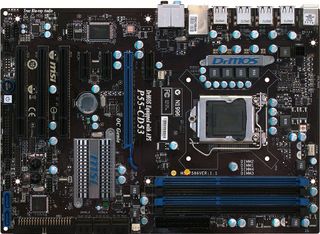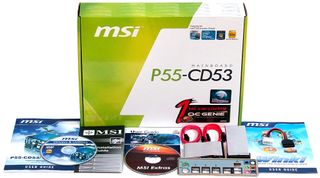P55 On A Budget: Five Core i5/i7 Motherboards For $100-$150
MSI P55-CD53
The first thing most people will notice about MSI’s P55-CD53 is that it has a load of rear-panel USB ports--and not much else. Yet, MSI does include four handy bench-testing features on the board’s surface: a power button, an overclocking-mode enabler, and two buttons for increasing and decreasing base clock.

The P55-CD53 also provides the floppy interface that some Windows XP users still need for adding RAID or AHCI drivers to their OS installation. The interface was already present in the motherboard’s multi-I/O controller, the connector is “almost free,” and many gamers still consider Windows XP a viable solution.

Yet the first thing we noticed wasn’t the board’s lack of I/O panel features, but instead its lack of voltage-regulator phases. MSI often uses slightly higher-capacity regulators in reduced numbers to save money without sacrificing durability, but this five-phase design--complete with a four-pin ATX12V connector--makes the board’s low $120 price very believable.
With a full seven expansion slots and very few onboard connectors, there’s little for us to criticize in the P55-CD53’s layout, but we did find two slight problems: both the front-panel audio and floppy interfaces are far too distant from the devices they serve to be easily connected. In fact, the front-panel audio cables of some cases simply won’t reach this far.
Use of a circuit board that’s an inch narrower than full-size leaves DIMM slots unsupported, something builders will notice right away when adding RAM to the forward slot. This might be forgivable given the P55-CD53’s low price, so long as it overclocks and performs well.
BIOS
MSI's Cell Menu is slightly simplified for this low-cost model, but includes most of the controls we rely on for our own CPU- and DRAM-overclocking evaluations.
Stay on the Cutting Edge
Join the experts who read Tom's Hardware for the inside track on enthusiast PC tech news — and have for over 25 years. We'll send breaking news and in-depth reviews of CPUs, GPUs, AI, maker hardware and more straight to your inbox.


CPU, PCH, and DRAM voltage controls are all present and include significantly-high ranges, but we were disappointed with the lack of droop compensation or the ability to key-in the target CPU voltage.
More significant is the missing Uncore voltage setting, which is especially odd on a board that includes amplitude control.


DRAM timings are adjustable down to impressive 4-3-3-9 latencies.

Six custom profiles can be stored locally, while a retry counter determines how long a user must wait before POST failures reset current values.
Accessories

In addition to the expected drivers, cables, and documentation, the P55-CD53 includes a floppy cable and hard drive copying utility. Unfortunately, only two Serial ATA cables are present.
Current page: MSI P55-CD53
Prev Page Gigabyte P55-UD3R Next Page Hardware And Software Configuration-
dirtmountain The Asrock P55 Pro is 16x-4x, not 8x-8x.Reply
http://www.asrock.com/mb/overview.asp?Model=P55%20Pro
http://www.newegg.com/Product/Product.aspx?Item=N82E16813157171
The Asrock P55 Extreme at $140 offers 8x-8x -
JeanLuc Good read but it really just confirms what a lot of us have known for a long time. Don't buy budget motherboards (MSI, ASrock, ECS) if you want to overclock and it's no coincidence that the boards from Gigabyte and Asus passed with flying colours as these companies clearly have proper testing procedures in place and quality assurance measures to avoid such issues.Reply -
evongugg Another great article from Tom's, letting us know about how one of these motherboards can burn your CPU. Never would have known without you.Reply
Might have burnt out a CPU and not know the cause.
-
Crydee How would P55 stack up against non P55s is what I wanted to see as well. See if the premium is worth it over the more budget friendly P55.Reply -
avatar_raq Unfortunately neither Gigabbyte nor ASUS boards offer the 8x8x PCI-e slots for multiple GPUs. I think it's better to wait for their premium brethren to fall below $150 before upgrading.Reply -
SchizoFrog For the extra $20 you can get the ASUS P7P55D PRO which is a much better board and offers the full spec for multi GPUs... However, I personally can only recommend what I would do myself and that is to wait. There are a lot of major PC spec changes over the next 6 months. So I am waiting for USB3 and SATA3 to make it to mainstream.Reply -
SchizoFrog For the extra $20 you can get the ASUS P7P55D PRO which is a much better board and offers the full spec for multi GPUs... However, I personally can only recommend what I would do myself and that is to wait. There are a lot of major PC spec changes over the next 6 months. So I am waiting for USB3 and SATA3 to make it to mainstream.Reply -
helms I doubt their quality assurance is as good as you think Jeanluc. Both Gigabyte and Asus make crap DDR3 controllers for socket 775 motherboards. I've tested a heap of DDR3 socket 775 boards from Asus and Gigabyte, the Asus P5Q3 in particular is causing a lot of problems. When paired with a quad core cpu (everything stock) and running 3 threads prime(blend) + furmark, the system would inevitably freeze in under 2hr's (usually within the 30 minutes mark, quite a bit less than 2hrs). In fact systems with those boards would freeze even during normal non PC intensive use such as browsing the internet. Running prime+furmark just forces it happen rather than waiting for it to freeze which is quite random during light use like word prcoessing. I doubt Asus even realizes that their P5Q3 is a faulty product and shouldn't have hit retail stores. They have been selling the P5Q3 for ages. They probably tested the board with a cheap dual core celeron and since it worked with that called it a day.Reply -
burnley14 JeanlucGood read but it really just confirms what a lot of us have known for a long time. Don't buy budget motherboards (MSI, ASrock, ECS) if you want to overclock and it's no coincidence that the boards from Gigabyte and Asus passed with flying colours as these companies clearly have proper testing procedures in place and quality assurance measures to avoid such issues.Reply
I think you're jumping to conclusions here. Tom's reviewed some boards a while back for the 1366 socket and gave ASRock first place for quality and value.
Most Popular


